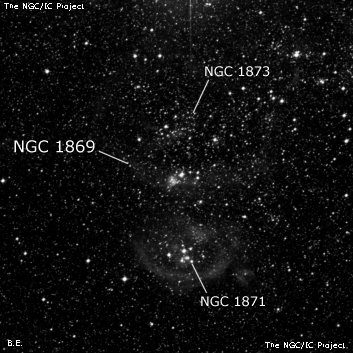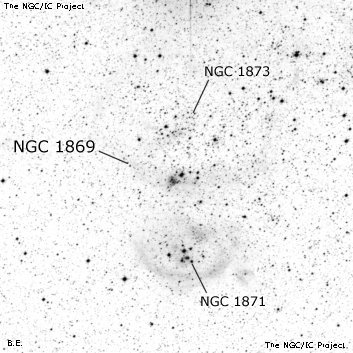NGC/IC Project Restoration Effort
(This is a very very beta version)
NGC1869


Basic Information
Location and Magnitude
Right Ascension: 5:13:52.0
Declination: -67:22:40
Constellation: DOR
Visual Magnitude:
Historic Information
Discoverer: Dunlop
Year of discovery: 1826
Discovery aperture: 9.0
Observational
Summary description: Cl, L, pRi, st sc
Sub-type: OCL+EN
Corwin's Notes
=====
NGC 1869, NGC 1871, and NGC 1873 are three concentrations in a large (10 x 9
arcmin), scattered stellar association in the LMC. I put the center of the
association somewhat northwest of JH's position which coincides with NGC 1869.
Here are his two observations:
05 13 58.4 157 34 10 (1830.0, NPD) Cluster of the 7th class; a fine L
cluster of sc sts which fills the field. The point taken is in the middle
of 3 groups in the most condensed part. [Sweep] 658 [on 20 Dec 1835.]
05 14 03.9 157 34 03 (1830.0, NPD) The first of a series of clusters which
extends northwards as far as B 922 [theta Doradus given its number in the
Brisbane Catalogue]. [Sweep] 760 [on 2 Jan 1837.]
My brief note in earlier versions of this file referred to only JH's first
observation, overlooking the second. Coming across this again in November
2013, I see that the "most condensed part" consists of three more or less
conspicuous clusters aligned north to south on the eastern side of the
association. I also found that each of these three clusters has a separate
entry in JH's list. The second of them is NGC 1871, and the third is NGC
1873, all taken in that January 1837 sweep.
It's finally clear to me (and I hope to you, if this note is not too dense),
that JH's first observation of "NGC 1869" in December 1835 refers to the
entire complex, while his second from January of 1837 points specifically to
the middle of the three clusters.
I have adopted this middle cluster as "NGC 1869". I have also created an
entry in the big table for an "NGC 1869 star cloud" which uses my earlier
position for the entire association as I see it on the DSS images. The
positions labeled with the numbers NGC 1869, 1871, and 1873 are for the
specific groups of stars within the larger complex as picked up by JH in
January 1837.
Steve's Notes
=====
NGC 1869
30" (10/12/15 - OzSky): S-L 326 (middle of three clusters within a large star cloud) consists of a mag 11.5 star, along with 5 other fairly bright stars and a number of faint stars (12-15 total resolved). The cluster is encased in an irregular HII glow with a brighter patch to the southeast of the mag 11.5 star. Moderately enhanced with the NPB filter, which reveals nebulosity extending off the cluster to the west. NGC 1873 lies 3' N and NGC 1871 is 4.5' S. All three clusters appear as local enhancements anchored by bright stars and lie within a striking star cloud (large association of blue supergiants including LH 32/34/36/37/38). A rich background glow of unresolved stars extends west and north.
13.1" (2/20/04 - Costa Rica): fairly faint, hazy glow (= S-L 326) around a mag 10.5 star (HD 269183) with a couple of mag 12 stars close west. NGC 1873 lies 2.7' N with 1871 4.4' S. Located 11.5' S of mag 4.9 Theta Doradus. Shapley used NGC 1869 as the center of Constellation IV, an association of blue supergiants.



